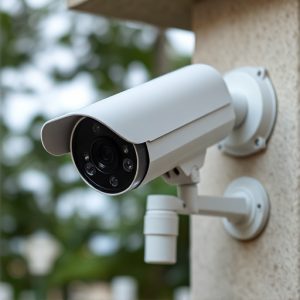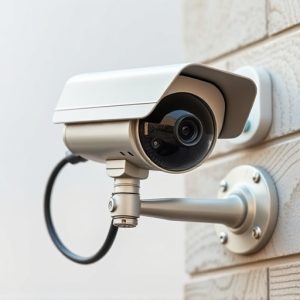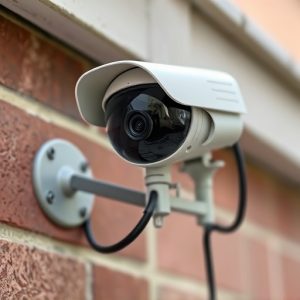Realistic Dummy Cameras: Market, Materials, Integration & Legalities
The market for realistic fake surveillance equipment is booming due to demand from homeowners and bu…….
The market for realistic fake surveillance equipment is booming due to demand from homeowners and businesses seeking discreet security. Choosing the right dummy camera shape, like bullet or dome styles, is key to deterring burglars while blending with environments. The "Realistic Dummy Camera Shape Choice" involves considering application, environment, desired realism, material (like durable plastics), and size to match genuine cameras. Manufacturers use advanced molding techniques to create high-quality plastics that mimic real metal or glass, resulting in authentic textures and weights. These fake cameras deter intruders by appearing genuine but do not provide video data, primarily serving as a deterrent. Ethical considerations and compliance with local laws are crucial to balance security and public trust.
In today’s digital era, realistic fake surveillance equipment is a growing market, offering both innovative solutions and ethical dilemmas. Understanding the demand for these lifelike dummy cameras, often chosen for aesthetic or security reasons, is crucial. This article explores the key factors in selecting the ideal realistic dummy camera shape, the materials used to craft them, their integration with actual security systems, and the essential ethical considerations and legal aspects that come into play.
- Understanding the Market for Realistic Fake Surveillance Equipment
- Key Factors to Consider When Choosing a Dummy Camera Shape
- Types of Materials Used in Crafting Realistic Looking Fake Cameras
- Integration with Actual Security Systems: Possibilities and Limitations
- Ethical Considerations and Legal Aspects of Using Fake Surveillance Equipment
Understanding the Market for Realistic Fake Surveillance Equipment
The market for realistic fake surveillance equipment has seen a surge in demand, driven by various factors. Homeowners and businesses alike are increasingly investing in what appears to be genuine surveillance technology to deter burglaries and enhance security perceptions. This trend is particularly noticeable among those seeking discreet solutions that blend seamlessly with existing environments, without the costs and complexities associated with professional installation of real cameras.
Choosing the right realistic dummy camera shape is a key consideration for consumers. Manufacturers offer a diverse range of options, from bullet cameras to dome cameras, each designed to mimic the appearance of authentic surveillance equipment while serving as an effective deterrent. The market’s responsiveness to this demand underscores the growing importance of visual security as a means of protecting assets and providing peace of mind in both residential and commercial settings.
Key Factors to Consider When Choosing a Dummy Camera Shape
When selecting a realistic dummy camera shape, several key factors come into play. Firstly, consider the application and environment where the fake camera will be placed. Different settings demand diverse designs; for instance, a dummy camera meant for an indoor office space might differ from one intended for outdoor use in harsh weather conditions. The level of realism required is another critical aspect; some devices mimic genuine cameras almost perfectly, complete with lens details and LED indicators, while others focus on basic shapes and materials to blend into the surroundings without drawing too much attention.
Additionally, material choice plays a significant role. High-quality plastics can offer exceptional durability and flexibility, enabling the dummy camera to withstand outdoor elements or subtle manipulation. Some advanced models even incorporate motion sensors or low-light simulation features, further enhancing their realism. The size and dimensions should also match authentic cameras to ensure seamless integration without attracting unwanted scrutiny.
Types of Materials Used in Crafting Realistic Looking Fake Cameras
In crafting realistic-looking fake surveillance equipment, the choice of materials plays a pivotal role in achieving an authentic appearance and feel. Manufacturers often opt for high-quality plastics that mimic the properties of real metal or glass, ensuring the dummy cameras have a convincing texture and weight. These plastics are carefully molded to replicate the intricate details of real camera components, from the lens to the housing.
The design process involves careful consideration of the realistic dummy camera shape choice, focusing on subtle nuances that set them apart from genuine equipment. This includes precise dimensions, accurate curves, and even replica logos or markings. By combining advanced molding techniques with expert craftsmanship, these fake cameras become nearly indistinguishable from their authentic counterparts, serving as effective deterrents in various security scenarios.
Integration with Actual Security Systems: Possibilities and Limitations
The integration of realistic dummy cameras, mimicking actual surveillance equipment in shape and design, offers both exciting possibilities and certain limitations within security systems. These fake cameras can serve as an effective deterrent for potential intruders, as their presence alone suggests a robust security setup. The market provides various options when it comes to choosing the right dummy camera, offering different levels of realism in terms of appearance and movement—from static models to those with subtle, pre-programmed pan-tilt-zoom (PTZ) functions.
However, while these realistic dummy cameras can enhance visual security, they have limitations. They do not provide actual video surveillance data and cannot replace real security cameras entirely. The primary function is to trick would-be criminals into believing they are under constant observation, thereby deterring criminal activity. But in terms of data collection, analysis, and real-time monitoring, traditional security systems with active cameras remain indispensable.
Ethical Considerations and Legal Aspects of Using Fake Surveillance Equipment
The use of realistic-looking fake surveillance equipment, often designed to mimic actual cameras, raises several ethical and legal questions. While these dummy cameras can serve as valuable tools for security testing and mockup scenarios, their deployment must be carefully considered. One primary concern is privacy invasion; using such devices in public spaces without proper disclosure could infringe on individuals’ rights, leading to potential legal repercussions.
Additionally, the realistic dummy camera shape choice should prioritize ethical boundaries. Creating equipment that closely resembles real surveillance gear can inadvertently foster a culture of surveillance and mistrust. It’s essential for manufacturers and users to strike a balance between providing security solutions and respecting public trust. Compliance with local laws and regulations is crucial, ensuring that the use of fake surveillance equipment aligns with privacy protection standards and does not facilitate unlawful activities.
The market for realistic fake surveillance equipment offers a unique blend of creativity and security solutions. By understanding the key factors, material choices, and ethical considerations, individuals and businesses can make informed decisions when selecting these devices. When integrated responsibly with actual security systems, realistic dummy cameras provide both visual deterrents and valuable testing tools. Ultimately, the choice of a suitable realistic dummy camera shape depends on specific needs, ensuring effective security measures while navigating legal boundaries.


